Our journey thus far has mainly taken us around the warmer parts of Europe. During our initial planning, we had realised that none of us had ever seen a glacier, a deficiency that we were keen to remedy. Research showed that there was one accessible from the Swiss town of Grindelwald that was itself reachable by rail, so we boarded a train in the sunny Italian coastal town of Genoa, and rattled up into the snow-capped Alps.
The heating in the train climbed higher in step with our increasing altitude, and by the time we reached Lucerne, our compartment felt like a furnace. I took advantage of the situation to wash all my underwear in the lavatory basin. It was wasteful of washing powder because there was no plug in the sink, but I’d bought a whole packet in Hungary for only 15 pence so I wasn’t complaining. I even managed to (shock horror) wash my feet.
We changed to the local service to Interlaken, and I was contentedly contemplating the view out of the window, and musing quietly on how each Swiss village seemed to be comprised of a mixture of affluent houses interspersed with poor shacks, when a group of American ladies joined the compartment. As we had discovered was usual for tourists from that country, they immediately started talking very loudly and all at once. It was difficult to avoid hearing that they had only just been talking to some random people on the platform, and that it was for some reason very important to discuss interminably and at full volume where each of those strangers had come from, where they had been going, and who was related to whom. When we escaped them at Interlaken, they were still going at it hammer and tongs.
Grindelwald (Switzerland)
The route up to Grindelwald from Interlaken begins with a trip on one of the famous Swiss cog trains, which have a third toothed rail that is engaged by a driving cog underneath the engine. This enables the train to climb steep gradients even if the rails are slippery with ice. Cog trains are run by private companies and they do not form part of the network covered by our Interrail pass. Andrew and I forked out the four quid for the return journey, but David chose instead to save the money, and to seek out a restaurant that sold fondue.
At Grindelwald station, we stored our rucksacks in lockers, and then sat outside a supermarket until it opened for the afternoon. We needed to stock up on food and supplies for our upcoming trek.
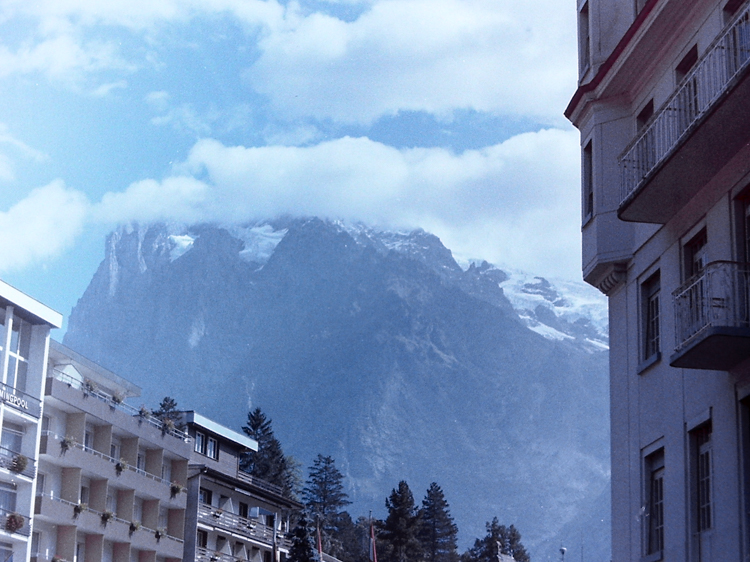
The Eiger, looming over Grindelwald.
For another two pounds, Andrew and I took the cable-car one-way up to Pfingstegg, and then set off to walk the mountain trail to Stieregg.
There were a fair few hikers on the trail, but they were swiftly forgotten when we realised that the valley below contained our first glacier. It was an impressive beast, rugged ice covered with gravel and large boulders, split haphazardly by crevasses and underlain by the roar of the sub-glacial river. As we hiked closer, we could see the cirque at the top, giving birth to a huge tongue of glacier spilling out to fall in frozen time vertically down the mountain. We continued on in awed silence, the jingle of sheep bells only broken by the occasional crack of ice, or a roar as an icy avalanche cascaded down the face of the cirque above.
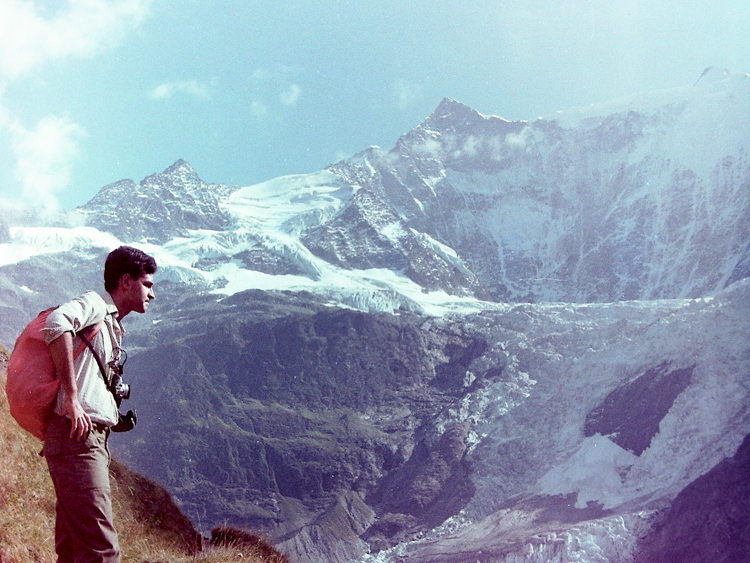
Andrew at the Bergrestaurant Stierreg, looking out on the cirque of the Lower Grindlewald glacier.
At the end of the trail is a little oasis of green, the Bergrestaurant Stierreg, where we sat with a restorative hot chocolate and watched the ice fall down the mountain.
Editor’s note – don’t go looking for the restaurant now, it was destroyed in 2005 when hundreds of thousands of cubic metres of the permafrost moraine on which was built, melted and fell into the valley.
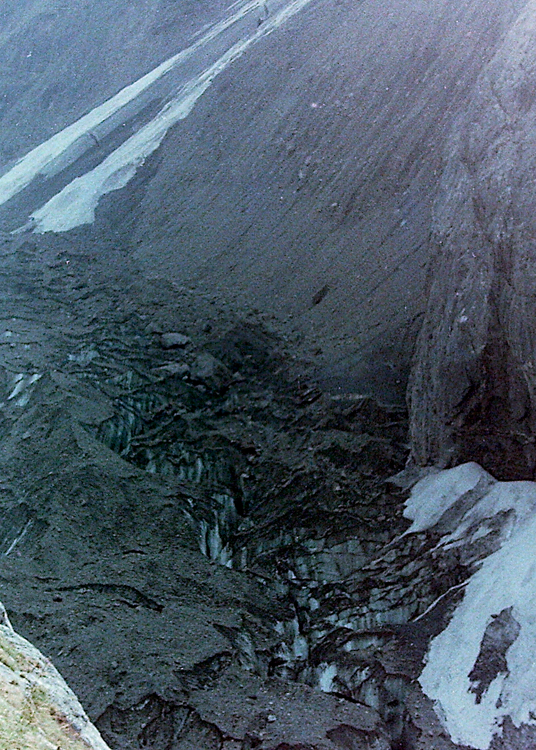
Unter Grindelwald glacier 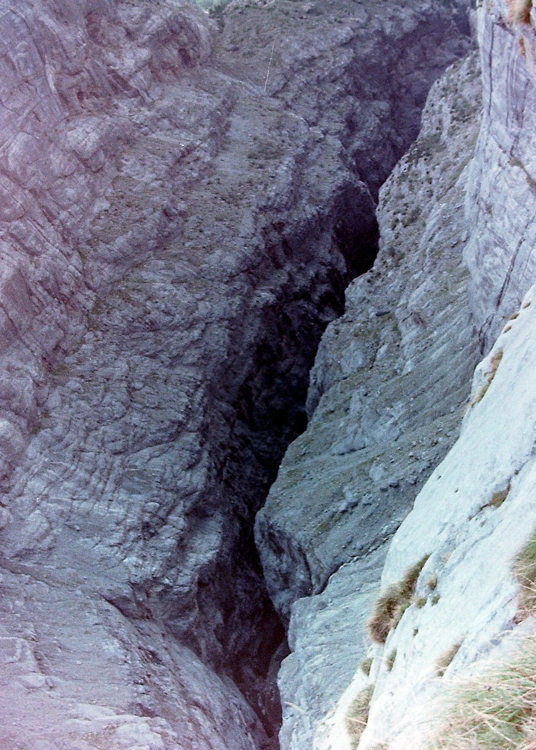
We set off back down the glacier, and then branched off onto the trail that would take us back down to Grindelwald. The path was long and tortuous and led over many small bridges, large gorges, and steep tracks. It descended below the tree-line, giving us fantastic glimpses of the Eiger and other Alpine peaks, and became so steep that at times it was more comfortable to run than to walk.
We had a fantastic walk, and finished up with a gentle stroll through the spacious town of Grindelwald to the lower Grund station, where we sat on a bench and dined on canned ravioli.

On top of the world, with a Mars Bar 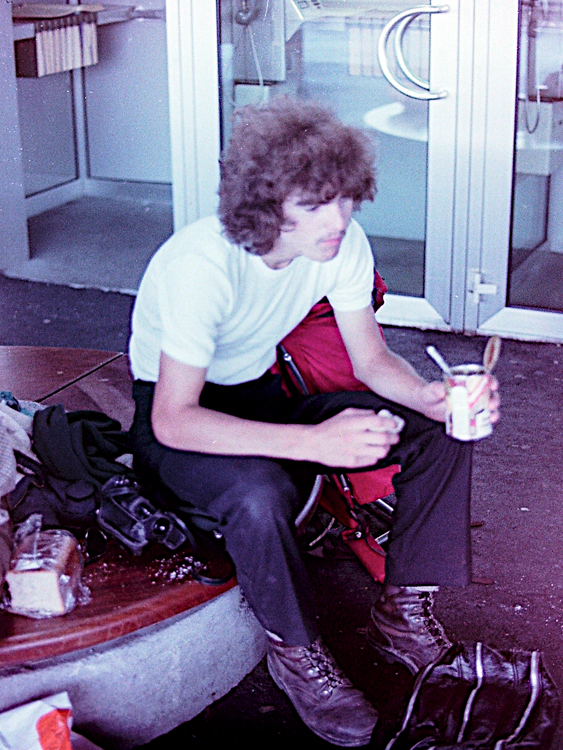
Very tired, with tinned ravioli, at the bottom
Just as our train came in, we suddenly remembered that we’d left our backpacks at the main station on the other side of town, so we trotted off uphill again as the sunset turned the snow-caps pink above us, the Wetterhorn to the East glowing quietly orange over the steeply sloping eaves.
Interlaken (Switzerland)
Reunited with our packs, we caught the next cog train down to Interlaken and met up with David, who had found several purveyors of fondue, but none at a price that he could afford.
It was getting late in the day, Switzerland is the most expensive country in Europe, we had already spent our entire budget for the day, and we needed somewhere to sleep. During his perambulations around the town, David had been keeping an eye open for opportunities, and had discovered an empty goods wagon shunted onto a siding at the rear of the station.
We quietly sneaked aboard and settled down for the night. In retrospect, we might have thought more carefully about the effect of an icy alpine wind blowing beneath the unsealed rough wooden floor of the goods wagon. At first I was comfortable enough rolled up in the outside of my survival bag, but I was awoken at 2 am when something triggered the security lights in the goods yard. I was pretty cold so I climbed inside. Since the survival bag is plastic, I would usually have set up one corner as a condensation trap, but it was dark and manipulating the bag is very noisy, so rather than wake the others, I just climbed inside.
I should have risked the noise, because a few hours later I woke up frozen and wet, stumbling around in the pitch dark, fumbling for my waterproofs, hat, and any other clothing that I could find, because I had lost my only warm jumper while running for a train back in Germany. Rolled up once more in the dry exterior of the bag, I managed a fitful sleep until dawn, when we caught the heavenly warm train to Lucerne.
Vaduz (Liechtenstein)
After a morning of messing about on Swiss trains, and some very close connections (lots of running!), we arrived in Buchs, which is as close as you can get by rail to the little independent principality of Liechtenstein. There was a wash-room at the station, and a cold wash and shave and a change of clothes made me feel much better after the uncomfortable night and stressful morning.
From Buchs, we took a brisk stroll from Switzerland through Schaan to Vaduz, capital of Liechtenstein. We could not locate a physical border between the two countries, but decided in the end that the change in the colour of the striped road sign poles from black-and-white to black-and-yellow marked the boundary.
The walk in the countryside was quite beautiful, with swallows above and hawks skimming the hedges. The other walkers were friendly, the weather was sunny and warm.
Vaduz itself did not announce itself with any signage, and in fact we only figured out that we had arrived by means of the names of some of the stores along the street. It seemed a pleasant town, and although almost all the shops were stamp dealers, we did locate a supermarket at which we stocked up on supplies.
After an eclectic yet filling lunch of tinned pie-filling accompanied by Italian grapes and Swiss bread and chocolate, washed down with German apple juice, we strolled back to Buchs and caught the next train out. We struck lucky with a DB fully convertible carriage with comfortable furry seats, which we rode all the way to Zurich.